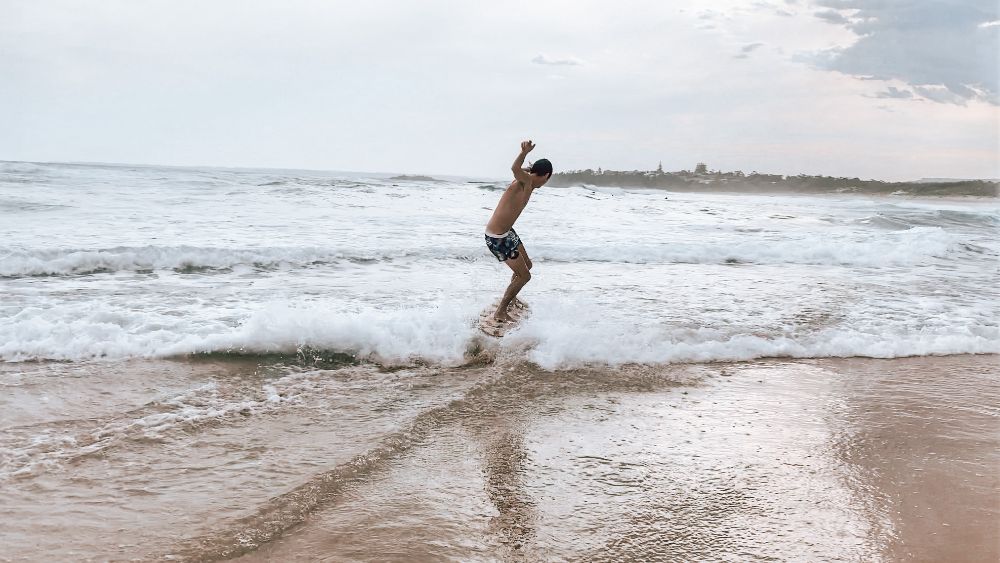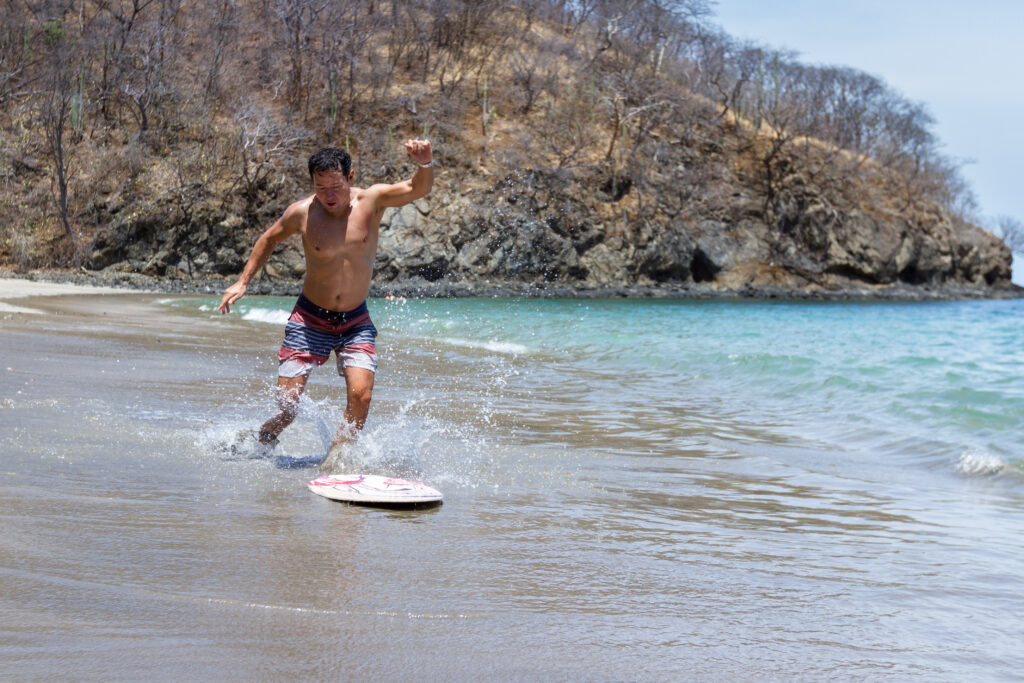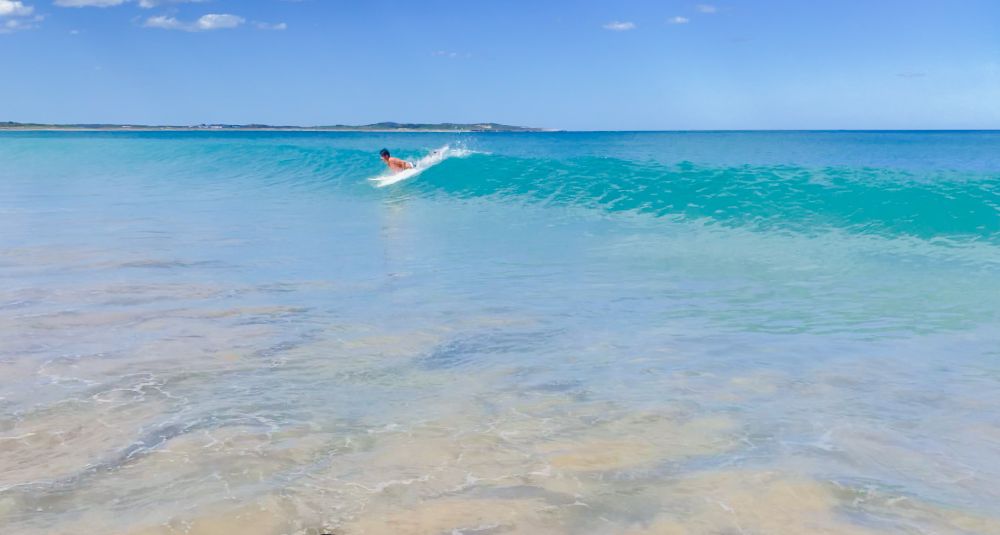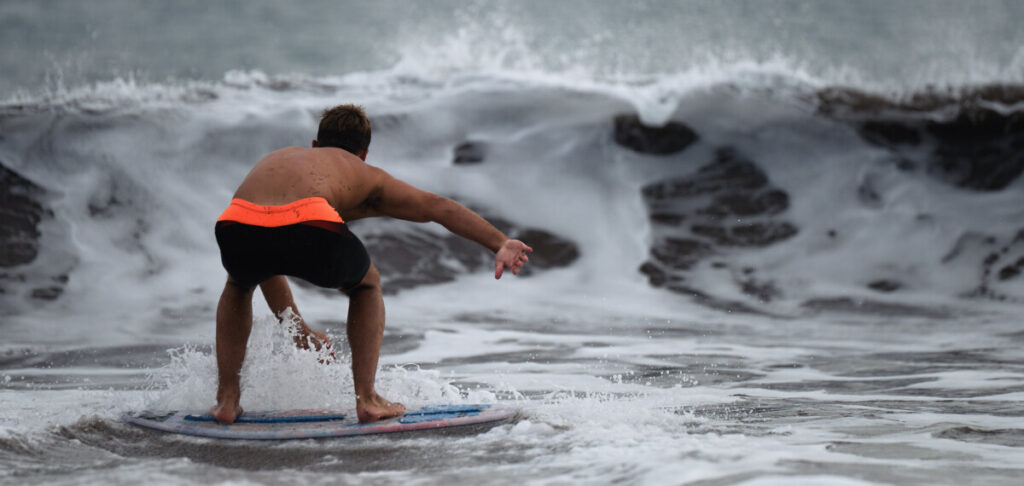Skimboarding is one of the most popular water sports on the West Coast. From Anaheim to Seattle, you can probably find a skimboarding community in any coastal town that you visit.
Skimboard can be dangerous due to a high liklihood of high speed falls into shallow water or on wet sand. Common injuries occur when skimboarders fall off their boards and can include rolled ankles or at worst even a fractured spine.
As a whole, most skimmers are at low risk of dying as they likely won't drown. However, when you are skimboarding it is critically important to keep your safety in mind.
Why is Skimboarding Dangerous?

Several factors make skimboarding a dangerous activity.
The biggest thing that leads to injuries is high speed falls. Skimboarding is after all running at high speed and jumping onto a small moving object.
You're usually skimming on wet sand or in very shallow water so when you fall and hit the ground you hit the ground HARD and at high speed.
Rolled ankles, broken collar bones or wrists and even spinal injuries are possible. This is why it's really important to start slow when skimboarding and then work up to higher and higher speeds as your skill level progresses.
This is unlike surfing, where a fall off of the board is unlikely to occur while the board is in shallow water. Surfers don't typically sustain serious injuries when they fall off their board. Skimboarders do.
Luckily enough for most skimboarders, spine damage is fairly rare. The risk of spinal damage increases when skimmers try to do more intense tricks. That doesn't mean that skimmers shouldn't try to do tricks on their boards, but it's important to be safe while doing so.
Another important factor is the toll skimboarding can take on your body, especially when you are new to the sport. Like other sports, skimboarding involves repetitive, intense movements of the body to be done correctly.
For skimmers, this often means developing pain in the hip or the legs and this was definitely true for me.
When I first started skimboarding all of the running and jumping onto the skimboard led to really sore muscles in my legs and my hips. I would need days to recover before going again.
But over time this got less as my body adjusted to the sport and became fitter.
While these types of injuries are inevitable, they can be put off for longer and made less severe if the skimmer is taking care of their body. Make sure to stretch before getting on the water and exercise consistently, as this will mitigate the risks of injury while skimboarding.
Other injuries that take place over time are sunburn, eye damage and Swimmer's Ear. These are caused by sustained contact with adverse ocean conditions such as bright sunlight and cold water in the ears. While they are usually treatable, the existing treatments take time and are uncomfortable for the patient.
Fortunately, skimmers can reduce the risk of both conditions fairly easily. By wearing sunscreen, sunglasses and ensuring all water is cleared from your ears after a session.
Additional Risks When Skimboard
Another big risk involved with skimboarding has to do with the skimboard itself. Skimboards are quite hard and when they hit you they can really hurt.
Because of this, there are several ways that the board can impact areas on the body including the ankles, the legs, and the groin.
Injuries to the shins, ankles and feet can be especially bad for skimboarders. These can happen by dropping the board whilst running and not placing your feet at the right timing.

It also possible when surfing big waves to come off the skimboard and the wave then push the skimboard into you leading to cuts and bruises. It's always a good idea to protect your head when coming off a wave if you think there's a chance your board might hit you.
Unlike other sports injuries, however, the risks of serious accidents can be decreased through experience and awareness of your skill level. As long as the skimmer is aware of their limits as an athlete and avoids doing anything stupid, they can bring their chances of incurring a board-based injury pretty low.
Also make sure you get the right skimboard shape for you and a good board can make learning how to skimboard a lot easier. Check out my beginners guide to buying a skimboard for more details.
Learn How to Fall
The most important thing skimboarders can do to stay safe during a fall is to know how to fall correctly. This largely comes from practice, but a few tips for beginners include:
- Don't try to break your fall: Even if you don't break your wrist the first time you try to break your fall, the repeated impact will cause an injury eventually. You may cause a more severe injury when you try to prevent your fall.
- Roll: You still might hurt yourself rolling, but it also transfers some of the impact from your body to forward movement, which can lessen the strain on your bones.
- Protect your head: Without trying to break your fall, this usually involves trying to land on your butt rather than any other part of your body. Your butt has plenty of soft flesh to slow the impact, and is unlikely to sustain serious injury.
- Fall away from your board: You obviously don't want to lose your board, but remember that unlike in surfing you won't be risking drowning without it. When you're not on the board, if it's moving quickly, it could hit you causing more damage than the fall would have on its own.
- Keep your board waxed: If you board isn't waxed properly the top can be slippery and you can fall off more easily. Click here to learn exactly how to wax a skimboard.
Is Skimboarding Safer Than Surfing?

It's hard to say which is safer. Surfing is easier to pick up, as surfers don't start surfing outright as skimboarders do. This means that beginners in particular are a little less likely to hurt themselves. However, surfing always carries with it the risk of drowning and death, something that is very uncommon for skimmers and surfboarders alike.
Skimmers also don't go as far out onto the water, which means that if they do get hurt they're more likely to be able to get help quickly. However, skimmers do have a higher risk of debilitating injuries like spinal cord injuries.
Most of the data we have on injuries comes from hospitals, which usually only need to treat living patients. There also isn't any data on minor injuries that don't make it to hospitals.
Because of this, surfing might be significantly more dangerous than skimboarding and we might not know. Thus it seems likely that despite the higher injury rate, skimboarding is still a bit safer than surfing for most people.
Read more about surfing vs skimboarding and the pros and cons of each




